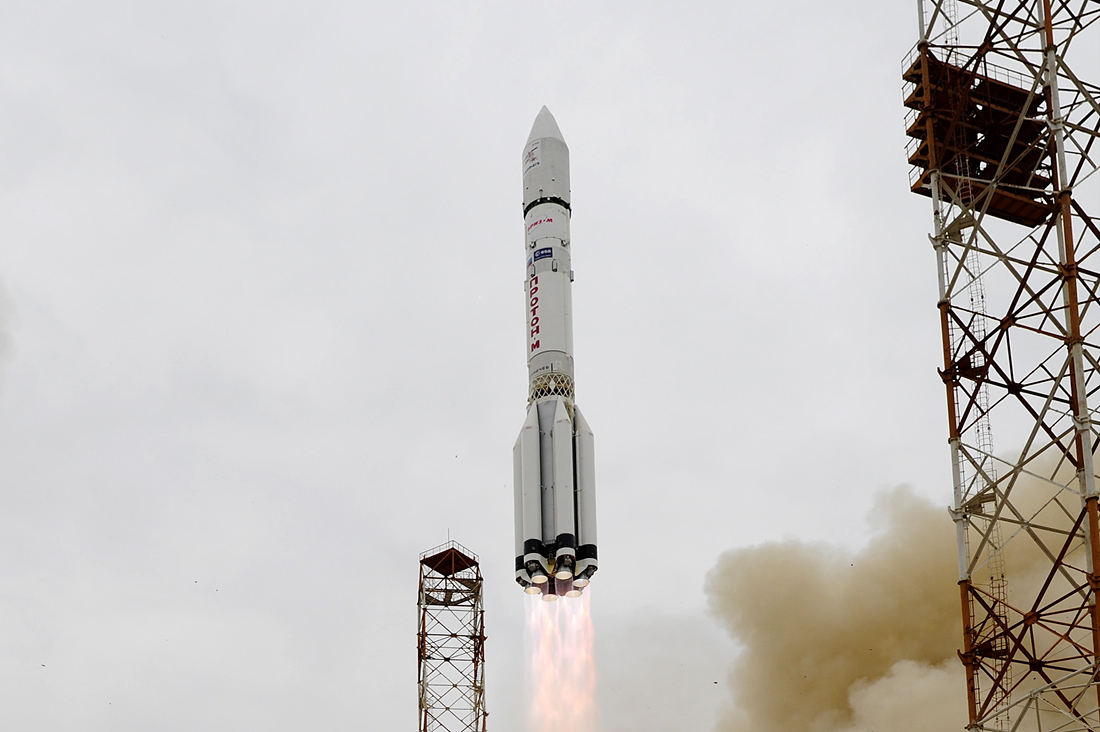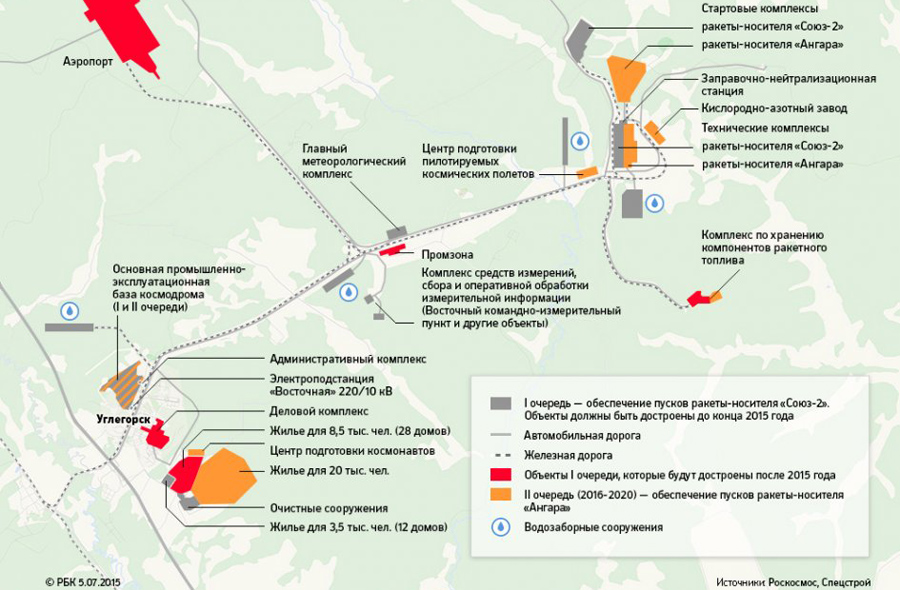
Roscosmos is going to
close the production of the Proton rocket. The most competitive and most
profitable civilian product on the foreign market, which has earned up to $ 10 billion over the past twenty years (4 annual budgets of Roskosmos), is closed as part of the “G. Khrunichev ". Proton is closing to clear the way for the Angara rocket, an environmentally friendly but uncompetitive rocket on the world market.
Of course, the refusal will not happen immediately, they promise to fulfill all of today's contracts, although there are not so many of them. Those. a couple of years “Proton” still flies, but then everything. In fact, this means that Roskosmos is completely withdrawing from the global launch market for geostationary satellites - the most monetary part of the commercial space launch market, which only 9 years ago, Russia occupied up to 60%.
The global commercial space market evolved in the 90s and 2000s, largely due to cheap Russian missiles. That is, the starving post-Soviet engineers on the technological backlog of the USSR created the conditions for the development of space services around the world so that today commercial space companies earn about
four times more money for telecommunications, navigation, and shooting the Earth every year than all the nations of the world spend on space. In 2010, an American entrepreneur Ilon Musk came to this developed market, who was able to offer a rocket a bit cheaper and a little more reliable than the Russians. Until today, he has managed to remove a good
layer of cream from the launch market, but today Roskosmos refuses to compete at all and surrenders without a fight.

The only rocket in the world that could compete almost equally with the most modern and partially reusable Falcon 9 Block 5
rocket is the “
Proton Medium ”, which was developed in the
agonizing Center for them without state financing. Khrunichev. “Angara” is
incapable of this in principle.
The rejection of “Proton” is due to the savings. Center them. Khrunichev is mired in debt, which he partially tries to repay through the sale of the Moscow territory of the enterprise. Now there is a transfer of production capacities to Omsk. Moscow Square Center. Khrunichev is being reduced, personnel are cut by half, and the remaining industrial sites are filled with equipment “
evacuated ” from the areas vacated for residential development. It seems there were not enough funds and resources for the Proton assembly line in Omsk. In addition, you can now save money by abandoning the “Proton” launch pads at Baikonur. Kazakhstan will gladly accept the cessation of the launch of a poisonous-heptyl rocket, with which they have long been dissatisfied with it, but are still suffering.
In the future, the closure of “Proton” leads to the complete withdrawal of Russia from Baikonur. The “Gagarinsky start” is already
closing . Two Zenit launch sites are transferred to the Kazakh side under the Baiterek program. Since 2014, the Dnepr conversion missile project has been closed due to disagreements with Ukraine. After abandoning Proton, Baikonur will have one active launch pad for the Soyuz-2 rocket. That is, from the space port, which today allows launches of all types of payloads on all types of orbits, Baikonur will return to the functional of 1961: the launch of manned near-earth ships and low-orbiting satellites with a Soyuz medium-load missile. And after the completion of the ISS manned program in 2024, the cosmodrome can simply be closed as unnecessary - the launch tables of the Soyuz are on both Plesetsk and Vostochny.
With the abandonment of Proton, Russia will lose access to the geostationary orbit for its heavy satellites, and Angara will be able to replace it only after 3-4 years, i.e. for this time, Roskosmos not only loses its commercial prospects, but also endangers the government’s task of maintaining access to space.
The decision to close the “Proton” is difficult, but forced. This rocket, which today has a low price due to the sophistication of technology and low wages, and is in demand in the global and domestic markets. True, because of the tainted accident statistics, it has a high interest rate on insurance, and Falcon 9 loses. “Proton” is created using outdated technologies, has toxic fuel that is more expensive, and is launched only from Baikonur, i.e. his launches are dependent on the political climate in Russia's relations with Kazakhstan. According to the previous plans of Roscosmos, the “Proton” was supposed to fly until 2025, although there are no apparent reasons to stop at this year.
On the other hand, the Angara is an “environmentally friendly” (more precisely, simply non-toxic) rocket, which is only in experimental production, has more complex and expensive engines, requires flight tests, and is 1.5–2 times more expensive than “Proton”. Under the “Angara”, only one launch pad was built in Plesetsk, from which launches of heavy geostationary satellites with the current version of “Angara” are impossible. It is possible to increase its payload by about one and a half times at the expense of the hydrogen stage - now such a rocket is called the “super heavyweight version”, although it will be one and a half times as inferior to the Falcon Heavy rocket. Either it will be necessary to build a launch pad under the “Angara” on the East. There were such plans, but the construction of the “second stage of the Vostochny cosmodrome” is delayed. The high cost of construction and budget cuts first forced Roskosmos to abandon one of the planned two launch tables for the “Angara”, and then decided to shift the construction costs to the Ministry of Defense. Today it is already possible to forget the former characteristics of the Oriental as “the first civilian spaceport of Russia”.

It turns out savings on the “Proton” imaginary - to transfer production and save the launch tables will be cheaper than to master mass production from scratch and build new launch sites. The problem is that Roskosmos cannot abandon the “Angara” because for too long it has been convincing everyone around and itself to its advantage for the future of the national cosmonautics. A bet on “Angara” is an attempt to save twice: to abandon the overhead of “Proton” and pass the cost of launching tables and flight tests of the “Angara” to the Ministry of Defense, which is the most rejection of geostationary launches for at least a year. This is the embodiment of the current desire of Roskosmos to reduce costs and increase revenues, which all have long demanded of him. Unfortunately, this “business plan” virtually eliminates attempts to compete in the external market and closes Roscosmos on the state order.
But the rejection of “Proton” frees up opportunities for Russian private traders. For example, the company S7 Space intends to actively enter foreign markets with a
restored Zenith or a future Soyuz-5 rocket manufactured by RSC Energia or even a reusable Soyuz-5 SL rocket of
its own production . The rejection of “Proton” is beneficial to S7, since it frees up market share. Although now the company's business is blocked by the same Roscosmos because of its unwillingness to sell components for the Russian-Ukrainian Zenit rocket, which S7 Space could launch today. The option of launching something other than Zenith or the future Soyuz-5 from the offshore platform S7 Space is excluded for technical reasons.
It seems so far no one is considering the possibility of giving “Proton” to private traders, although there is some sense in this. The production of “Proton Middle” is almost established, there are production facilities, there are personnel, there are pads, all the necessary international agreements exist, there is a market. If a private owner appeared in Russia, ready to invest $ 300-500 million in his own rocket business and continue to compete in the world market, then Roskosmos would probably agree to give it a well-deserved, but unnecessary, rocket together with the production and launch sites.